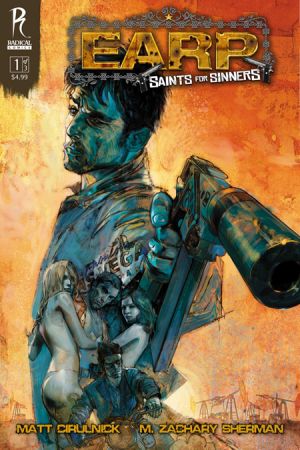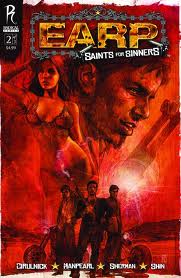- Comics
- Comics Reviews
- Manga
- Comics Reviews
- European Comics
- News
- Comics News
- Press Releases
- Columns
- Spotlight
- Digital Comics
- Webcomics
- Cult Favorite
- Back Issues
- Webcomics
- Movies
- Toys
- Store
- More
- About
By Andy Frisk
January 19, 2011 - 19:37
Set in the fictional future America of circa AD 2030, Earp: Saints for Sinners is nothing really new as far as storytelling goes. If you’re anywhere near aware of the story (legendary or otherwise) of Wyatt Earp, the most fabled lawman of the Old American West, then this first issue of the series is not anything groundbreaking. What makes Earp: Saints for Sinners so interesting is not its re-imagined heroes Wyatt Earp and Doc Holliday, it is its setting:
“Black Thirty was a stock market cave-in that lasted thirty months. It threw the whole world into depression. So guys who were raking in fat bonuses started throwing themselves out their office windows. Everyone else just lost their homes. Some blamed it on banks making bad loans. Others blamed it on a generation that idolizes whores, easy money, and fame instead of hard work. There were food riots, gas riots, looting—violence hit an all-time high. Local precincts were under-funded and undermanned. The people needed to help police themselves—so The Provocation Challenge Act made dueling legal. It brought a little character back to society. Gun sales went up, but violence went down. Seems when you known you could get shot for acting the fool or just running your mouth, you tend to think twice...”
 |
Electronic banking is also a think of the past in this neo-Wild West world. “With all the Russian and Chinese hackers out there, electronic banking was dead. Cash was king again.” With cash being king, it needs to be moved from location to location, by train no less. The train robbery is reborn as well. Finally, the rise of the romantic folk hero of the bank robber, not seen “since the last depression,” dominates public interest, as do the lawmen made famous through their battles against them. All of these events, which are obvious exaggerations of real life events and ideas, combine to create the perfect setting for a retelling of the Wyatt Earp and friend’s legend. (Again, if you’ve never heard of Wyatt Earp before, I suggest the movie Tombstone as the perfect guide to the legendary Earp story. Like Earp’s story itself, Tombstone is nothing profound as far as storytelling goes, but it is an enjoyable piece of Wild West escapism). Basically, Earp is the world weary good guy who retires and ends up rejoining the fight against the bad guys and train robbers after losing his two brothers to such types. There’s a gun fight at the OK Corral, culminated with an epic standoff against the main evil doer (for all my literary readers I know that “epic” doesn’t really define or function as the proper descriptor for such an event as a standoff, but it’s just too hard to resist the urge to use the word since so many do in this way…). These elements are incorporated into the first issue of this series.
 |
Like stated though, it is the setting of this particular telling of the Earp legend that is so arresting (pardon the pun). With much of the world still emerging from or experiencing what many economists have dubbed “The Great Recession,” political types of the extreme persuasion advocating that every one should be armed and carrying guns around on them all the time in order to make sure that society is safe, and horrific events like those in Tucson, Arizona, perpetrated by what can only be deemed a mad man—not a political radical, even if influenced by America’s caustic political climate—is the world of Earp: Saints for Sinners really that much of a stretch to imagine coming to fruition? Frighteningly, no it is not. Regardless of the fact that authors M. Zachary Sherman and Matt Cirulnck feel that a portrayal of an America where everyone is armed to the teeth sees a drop in violent crime, this is a frighteningly and dangerously possible future scenario. Unfortunately, in the real world, legendary Wyatt Earp types don’t exist, but there are plenty of real life Jesse James types.
Reading through Earp: Saints for Sinners is like peering through a potential-future revealing crystal ball and cringing at what appears to be its simply fantasy, but instead is its scary potentiality. The desire to learn more about this near future world that so darkly mirrors our own is what drives the reader to want to continue to read the series. What other types of exaggerated contemporary event inspired future events will Earp and Holliday live through? Will there be any Bernie Madoffs around the corner, how about Blackwater type mercenaries who work for the highest bidder, and just what do those Russian and Chinese hackers do now that there are no electronic banking accounts to hack (well, there are some plot holes admittedly)? Finding out is a main part of the series’ draw. Earp’s personal story is in and of itself almost ancillary to the world that Sherman and Cirulinck have dreamed up for him to live through. This fact, coupled with Mack Chater, Martin Montiel, and Colin Lorimer’s artwork, which is firmly entrenched in the dark and painted style of nearly every Radical Publications books, make Earp: Saints for Sinners the second best series ever published by the group behind Time Bomb (and possibly the Shrapnel saga). These facts also make this series one of the most potentially and easily scrutinized, for its politics, prophetic potential, as well as its troubled heroes and villains out of all of Radical Publications’ books.
Rating: 8 /10